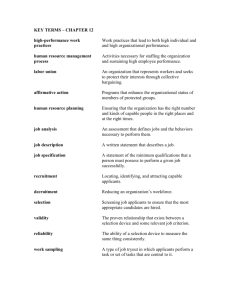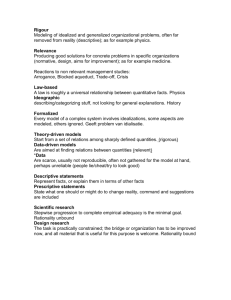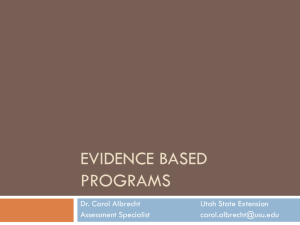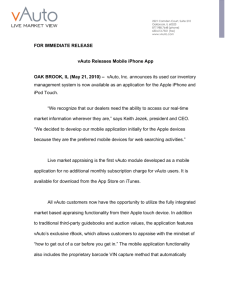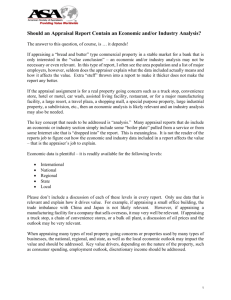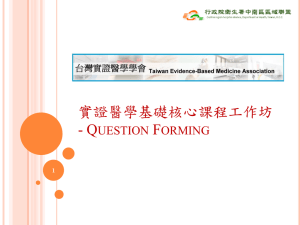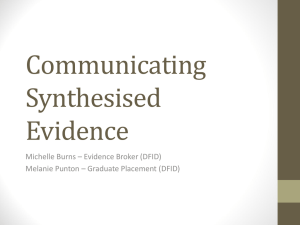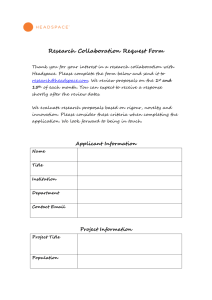ISQua Webinar - November 2015
advertisement
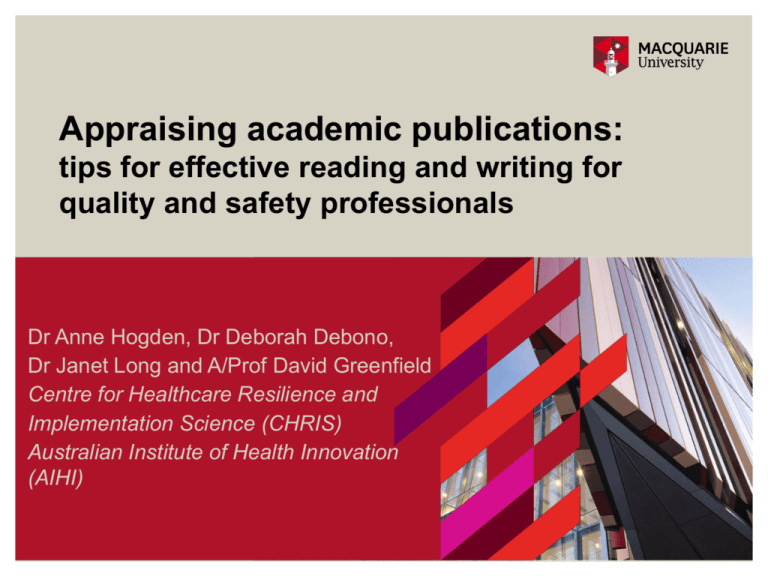
Appraising academic publications: tips for effective reading and writing for quality and safety professionals Dr Anne Hogden, Dr Deborah Debono, Dr Janet Long and A/Prof David Greenfield Centre for Healthcare Resilience and Implementation Science (CHRIS) Australian Institute of Health Innovation (AIHI) Presenters David, Deborah, Anne and Janet 2 Australian Institute of Health Innovation Our mission is to enhance local, institutional and international health system decision-making through evidence; and use systems sciences and translational approaches to provide innovative, evidence-based solutions to specified health care delivery problems. http://aihi.mq.edu.au/ 3 Purpose of the webinar Build on previous presentations given to ISQua Fellowship: • Previous webinars - January 2015 and May 2015 • Seminar at 2015 ISQua conference: “Healthcare research for quality and safety professionals: study design, implementation and translation.” Appraising publications is a useful skill to assist you plan and conduct your work: • Reading to inform your work or conducting evaluations and research • Writing up or presenting your project • Reaching a high standard for publishing your manuscript in peerreviewed journals • Acting as a reviewer for peer-reviewed journals 4 Agenda Analyse the overall coherence and cohesion of publications David Appraise the quality and rigour of each individual section Anne Identify limitations and how they could be improved Deborah Apply this knowledge to improve your own research work and writing Janet 5 Analysing coherence and cohesion of the publication Three approaches you can use, depending on your time constraints. Each approach is directed at taking a “big picture” look and answering several basic questions: 1. Does the aim match the method, leading to the findings and conclusion? 2. Do you find it credible? 3. Are you convinced? 6 Analysing coherence and cohesion of the publication Approach #1 Review the Abstract Questions to ask: Does the aim match the method, leading to the findings and conclusion? Do you find it credible? Are you convinced? 7 Analysing coherence and cohesion of the publication Approach #2 Examine the Introduction + Discussion and/or Conclusion Additional questions to ask: Are both sections grounded in the relevant, current literature? Is there a clear aim or objective that is answered in the discussion and conclusion? 8 Analysing coherence and cohesion of the publication Approach #3 Consider the whole paper from beginning to end, and back and forth at the same time Additional questions to ask: Is the paper well structured, written and easy to read? Are all sections grounded in the relevant, current literature? Is there a clear aim/objective that is answered in the discussion and conclusion? Do sub-sections add to addressing the research aim? 9 Appraising the quality and rigour of each section RATS guidelines: http://www.biomedcentral.com/authors/rats Relevance Appropriateness of method Transparency of procedures Soundness of interpretive approach Reference: Clark, JP. How to peer review a qualitative manuscript. In Peer Review in Health Sciences. Second edition. Edited by Godlee F, Jefferson T. London: BMJ Books; 2003:219-235 10 Appraising the quality and rigour of each section Relevance of study question ASK THIS OF THE MANUSCRIPT 1. Is the research question interesting? 2. Is the research question relevant to clinical practice, public health, or policy? THIS SHOULD BE INCLUDED IN THE MANUSCRIPT • Research question is explicitly stated • Research question is justified and linked to the existing knowledge base (empirical research, theory, policy) 11 Appraising the quality and rigour of each section Appropriateness of method QUALITATIVE STUDIES Is qualitative methodology the best approach for the study aims? • Interviews: experience, perceptions, behaviour, practice, process • Focus groups: group dynamics, convenience, non-sensitive topics • Ethnography: culture, organizational behaviour, interaction • Textual analysis: documents Study design is described and justified, i.e. why was a particular method chosen? 12 Appraising the quality and rigour of each section Appropriateness of method QUANTITATIVE STUDIES Is quantitative methodology the best approach for Study design described and the study aims? justified, i.e. why was a particular • Large scale surveys method chosen? • Pre-and post-test design • Longitudinal studies • Cross-sectional studies 13 Appraising the quality and rigour of each section Transparency of procedures SAMPLING Are the participants selected the most appropriate to provide access to the type of knowledge sought by the study? Is the sample adequate? RECRUITMENT Was the recruitment conducted using appropriate methods? Is the sampling strategy appropriate? Could there be selection bias? Criteria for selecting the study sample justified and explained • theoretical: based on preconceived or emergent theory • purposive: diversity of opinion • volunteer: feasibility, hard-to-reach groups Details of how recruitment was conducted and by whom Details of who chose not to participate and why 14 Appraising the quality and rigour of each section Transparency of procedures DATA COLLECTION Was collection of data systematic and comprehensive? Are characteristics of the study group and setting clear? Why and when was data collection stopped, and is this reasonable? Method(s) outlined and examples given (e.g., interview questions) Study group and setting clearly described End of data collection justified and described 15 Appraising the quality and rigour of each section Transparency of procedures ROLE OF RESEARCHERS Is the researcher(s) appropriate? How might they bias (good and bad) the conduct of the study, and the results? Do the researchers occupy dual roles (clinician and researcher) Are the ethics of this discussed? Do the researchers critically examine their own influence on the formulation of the research question, data collection, and interpretation of results? 16 Appraising the quality and rigour of each section Transparency of procedures ETHICS Was informed consent sought and granted? Were participants’ anonymity and confidentiality ensured? Was approval from received from an appropriate ethics committee? Informed consent process explicitly and clearly detailed Anonymity and confidentiality discussed Ethics approval cited 17 Appraising the quality and rigour of each section Soundness of interpretive approach ANALYSIS Is the type of analysis appropriate for the type of study? eg • Thematic: exploratory, descriptive, hypothesis generating • Constant comparison/grounded theory: theory generating, analytical Are the interpretations clearly presented and adequately supported by the evidence? Was trustworthiness/reliability of the data and interpretations checked? Analytic approach is described in-depth and justified Indicators of quality: Description of how themes were derived from the data (inductive or deductive) Evidence of alternative explanations being sought Analysis and presentation of negative or deviant cases Method of reliability check described and justified, e.g. was an audit trail, triangulation, or member checking employed? Did an independent analyst review data and contest 18 themes? Appraising the quality and rigour of each section Soundness of interpretive approach DISCUSSION AND PRESENTATION Are findings sufficiently grounded in empirical, theoretical or conceptual framework? Findings presented with reference to existing theoretical and empirical literature, and how they contribute Is adequate account taken of previous knowledge and what the findings add? Are the limitations thoughtfully considered? Strengths and limitations explicitly described and discussed Is the manuscript well written and Written for a health sciences audience accessible? 19 Identifying limitations and how they could be improved • What are study limitations? • What are not study limitations? • Why is it important to identify study limitations? Strengths Limitations 20 Identifying limitations and how they could be improved Types of limitations • Theoretical limitations • Methodological limitations Study design limitations Data limitations 21 Identifying limitations and how they could be improved Presenting study limitations • Are they described at all? • How well are they described? Critical reflection Evaluation 22 Identifying limitations and how they could be improved The implications of study limitations • Identifying areas for additional research • Conducting future studies 23 Applying this knowledge to improve your research and writing Relevance Target group Audience: journal articles, reports, conference presentations, study partners, industry Appropriateness Best method to answer the question Give reasons for your choices Transparency Keep a log What does the report look like? Soundness Results only Discussion 24 Applying this knowledge to improve your research and writing Report statistics using APA style guide E.g. http://my.ilstu.edu/~jhkahn/apastats.html The sample as a whole was relatively young (M = 19.22, SD = 3.45). The average age of students was 19.22 years (SD = 3.45). The percentage of participants that were married did not differ by gender, C2(1, N = 90) = 0.89, p = .35 There was a significant main effect for treatment, F(1, 145) = 5.43, p = .02, and a significant interaction, F(2, 145) = 3.24, p = .04. 25 Applying this knowledge to improve your research and writing • Draft your output • Check back on RATS to ensure all the criteria are addressed • Authors’ guidelines • Revise, review and rewrite • Critical review partners • Big picture “Great work is not written it is re-written” 26 Conclusions Effective reading and writing of academic publications, by: • analysing the overall coherence and cohesion publications • appraising the quality and rigour of each individual section • identifying limitations and improvements • applying this knowledge to your own research work and writing 27 Contact details Centre for Healthcare Resilience and Implementation Science, Australian Institute of Health Innovation, Macquarie University Dr Anne Hogden Dr Deborah Debono Dr Janet Long A/Prof David Greenfield anne.hogden@mq.edu.au deborah.debono@mq.edu.au janet.long@mq.edu.au david.greenfield@mq.edu.au 28 Australian Institute of Health Innovation The Australian Institute of Health Innovation (AIHI) comprises three centres: • Centre for Healthcare Resilience and Implementation Science (CHRIS), • Centre for Health Informatics (CHI), and • Centre for Health Systems and Safety Research (CHSSR). We are a major national resource for many people whose work is intrinsic to strengthening health systems, organisations and services. We strive to conduct world-class research with relevance to national and international research communities, governments, policymakers, providers of health services, managers, clinicians, patients and the community. http://aihi.mq.edu.au/ 29 Australian Institute of Health Innovation Our work underpins health reforms and systems improvement and provides new tools, perspectives and evidence to help stakeholders who are interested in making the health system more effective, efficient and productive. Our overarching aim is to produce new, high quality research evidence to support change and improvement. We are funded by the National Health and Medical Research Council, the Australian Research Council, NSW Health and many other supporters, partners and stakeholders. 30 31 Centre For Healthcare Resilience and Implementation Science The Centre for Healthcare Resilience and Implementation Science (CHRIS), formerly the Centre for Clinical Governance Research, has a successful track record of undertaking research and evaluation projects on health sector issues since 1991. Our core interest is to investigate issues of policy, governance and leadership in the health sector. We are involved in conducting original research providing a scholarly capability by which to evaluate health sector policies, programs and projects, and contributing to undergraduate medical, postgraduate health services management, and public health and al education. Website: http://aihi.mq.edu.au/chris 32
